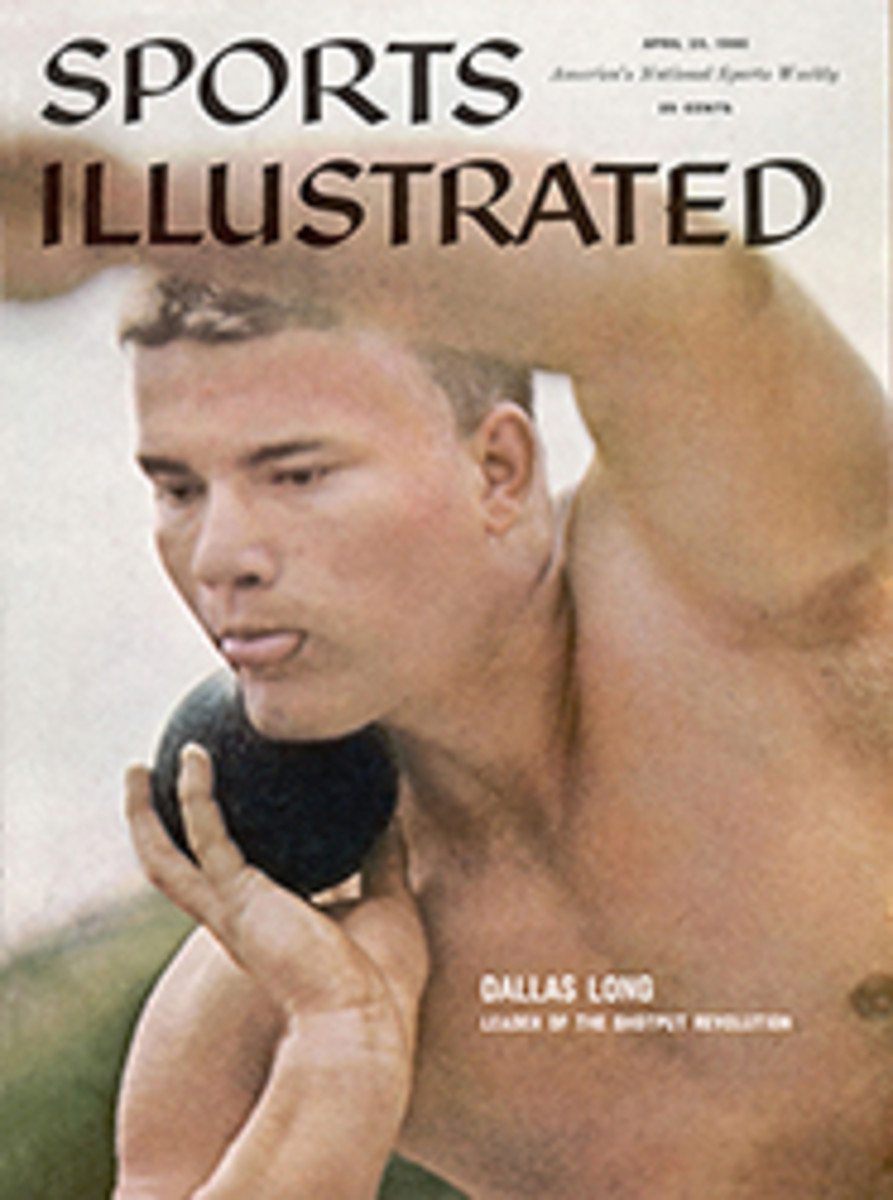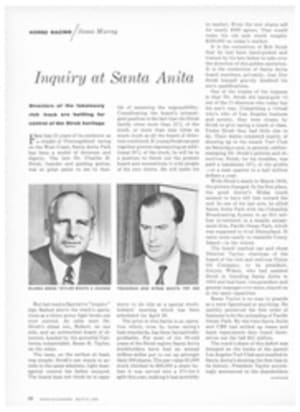
Inquiry at Santa Anita
For the 25 years of its existence as a citadel of Thoroughbred racing on the West Coast, Santa Anita Park has been a model of decorum and dignity. The late Dr. Charles H. Strub, founder and guiding genius, was at great pains to see to that.
But last week a figurative "inquiry" sign flashed above the track's operations as a bitter proxy fight broke out over control. At odds were Dr. Strub's eldest son, Robert, on one side, and an entrenched board of directors, headed by the powerful California industrialist, Reese H. Taylor, on the other.
The issue, on the surface at least, was simple: Strub's son wants to accede to the same absolute, tight managerial control his father enjoyed. The board does not think he is capable of assuming the responsibility. Complicating the board's intransigent position is the fact that the Strub family owns more than 21% of the stock, or more than four times as much stock as all the board of directors combined. If young Strub can put together proxies representing an additional 30% of the stock, he will be in a position to throw out the present board and reconstitute it with people of his own choice. He will make his move to do this at a special stockholders' meeting which has been scheduled for April 28.
The prize in this battle is an operation which, even by horse racing's lush standards, has been fantastically profitable. For most of the 20-odd years of the Strub regime Santa Anita stockholders have had an annual million-dollar pot to cut up amongst their 200 shares. The par-value $5,000 stock climbed to $80,000 a share before it was carved into a 375-for-1 split this year, making it less unwieldy to market. Even the new shares sell for nearly $300 apiece. That would make the old unit worth roughly $100,000 on today's market.
It is the contention of Bob Strub that he had been hand-picked and trained by his late father to take over the direction of this golden operation. It is the contention of Santa Anita board members, privately, that Doc Strub himself gravely doubted his son's qualifications.
One of the ironies of the impasse is that Dr. Strub did hand-pick 13 out of the 15 directors who today bar his son's way. Comprising a virtual who's who of Los Angeles business and society, they were chosen by Strub to give racing a touch of class. Under Strub they had little else to do. Their duties consisted mainly of showing up in the swank Turf Club on Saturdays and, in general, rubber-stamping Dr. Strub's policies and directives. Strub, for his troubles, was paid a handsome 10% of the profits—or a neat quarter to a half million dollars a year.
With Strub's death in March 1958, the picture changed. In the first place, the good doctor's Midas touch seemed to have left him toward the end. In one of his last acts, he allied Santa Anita Park with the Columbia Broadcasting System in an $11 million investment in a seaside amusement firm, Pacific Ocean Park, which was supposed to rival Disneyland. It came more nearly to resemble Coney Island—in the winter.
The board reached out and chose Director Taylor, chairman of the board of the rich and well-run Union Oil Company, to be president. Gwynn Wilson, who had assisted Strub in founding Santa Anita in 1934 and had been vice-president and general manager ever since, stayed on in the same capacities.
Reese Taylor is no man to preside as a mere figurehead at anything. He quickly perceived the first order of business to be the unloading of Pacific Ocean Park. By the time Santa Anita and CBS had settled up losses and bank repayments they found themselves out the full $11 million.
The track's share of this deficit was dumped on the books of the parent Los Angeles Turf Club and resulted in Santa Anita's showing the first loss in its history. President Taylor accordingly announced to the shareholders they could not expect a dividend for two years. This was illegal, said Bob Strub. Not so, countered Gwynn Wilson and the board. The company ran at a loss and thus cannot, under law, declare a dividend until it has shown six months of profitable operation. When the board of directors later voted to record its intent to pay a $6-per-share dividend, or $450,000, if projected earnings warranted that amount, Strub insisted the action was only an afterthought on the part of the board, provoked by his threat of a proxy fight.
SEARCH FOR A VILLAIN
Amid the sounds of battle, it was difficult for the interested to discern who young Strub thought was his personal villain. He complained that he had been dissatisfied with his own role in the company since his father's death but conceded he had voted with the majority of the board because dissent was futile. "I just didn't like the general direction of corporation management," he explained last week. "We are drifting to a certain extent." He found fault with Taylor because, "in the judgment of our group, however able Mr. Taylor may be in running that oil company, he doesn't have enough time left over to participate effectively in the management of the Los Angeles Turf Club and certainly not enough left over to carry on adequately and smoothly the duties of its chief executive officer." But when asked directly last week who he thought had been calling the signals at Santa Anita since his father's death, young Strub answered, "Reese Taylor."
Actually, Reese Taylor disclaims any ambition to rule Santa Anita. He insists, "I went into the thing as a matter of friendship to the Strub family. I took my job to be salvaging that pier operation [Pacific Ocean Park], and this I was able to do through my connections with CBS and others." The stock-splitting was done with the full consent of the Strubs, said Taylor. Taylor said he relied almost totally on Wilson in matters of track operation. The recommendation, he said, to bring in veteran Fred Ryan of Tanforan race track as general manager of Santa Anita, a job young Strub first coveted, was Wilson's recommendation, not his own.
It became abundantly clear that Gwynn Wilson, who stayed on as executive vice-president at the specific behest of the Taylor-led board (after an earlier intention to resign), had, at the very least, concurred in blocking young Strub's room at the top. What was particularly galling was the assigning of Strub to the Turf Club's Lake Arrowhead operation, a resort which Santa Anita bought in 1946 comprising an 800-acre lake and 3,200 acres of mountain land. It had operated at only a break-even basis in the 16 years Santa Anita had owned it. The rumor bruited about that "Bob Strub has been assigned to watch the lake" only served to exacerbate the wounded family pride.
DECLINED: ONE LAKE
But the bucket of ill-feeling was not tipped over and spilled in public until the end of the 1959-1960 meeting, when Executive Vice-President Wilson announced he would be resigning as of October 31, 1960. Bob Strub then began to lobby openly for the job. A majority of the board of directors voted not to give it to him at a meeting attended by 10 members. The board offered him, instead, the vice-presidency in charge of public relations, which looked to Bob like another lake to watch. He declined.
The board then took the position that for the 41-year-old Strub to campaign actively for the Wilson job "while he was a salaried officer...with active, full-time duties" was damaging to the company's relations with shareholders, the public and employees, and therefore out of keeping with his position. He was dismissed. Said Strub: "I was presented with the alternatives of being shunted out of management into a non-policy-making department or of resigning or being fired. I declined the first two alternatives. My removal, therefore, came as no surprise to me."
He struck back by releasing a statement noting that the Strub family, despite its large stock holdings, had only one director to represent it on the board. He announced he was organizing his own group of shareholders dissatisfied at "the effort to push me out of management."
His attack dismayed Santa Anita, even if the public enjoyed it. "Nobody wins a fire or a war," said Executive Vice-President Wilson. "I spent 27 years here and I hoped to leave it in amicability. Bob should remember that the board of directors had been chosen by Dr. Strub."
"Father was too trusting," sniffed Bob Strub in rebuttal. "My father's wishes are not being carried out. My father thought I was capable. We are disappointed in Mr. Wilson, who worked with my father for so many years. We had expected he would carry out my father's wishes. But Mr. Wilson is a nonstockholder and a salaried officer, and is loyal to his employers, who in this case are Mr. Taylor and the board. Mr. Wilson says that I was 'welcome' at management meetings. The only thing I can say is there is a vast difference between being 'welcome at' something after it's under way and being invited to it before it starts. I feel I was treated like a spare part."
COULDN'T CARE LESS, BUT...
President Taylor, whose family owns only one share of Santa Anita stock, allows it is a matter of complete indifference to him which side wins the upcoming proxy fight. ("I wanted to get out after settling the pier mess.") "Nevertheless," he says, "it wouldn't be fair to the stockholders just to walk out on this. I've got nothing to fight about, but in business you've got to be objective and I would like to leave the business in as good shape as possible."
Whether the 400-acre, $20 million track will remain in the hands of the Los Angeles business and professional men on the board of directors (who propose to replace Wilson with a management committee rather than one officer) or will revert to the Strub family, with which it has been identified since inception, will be decided next week at the stockholders' meeting. The board will pit its record and meager total of shares against the Strub family and allies, who need only a small balance of proxies to tip the scales in their favor. For once, there is no one to hang out a morning line at Santa Anita, but the battle promises to be woollier by far than an opening day race for 2-year-old fillies.
PHOTO
OILMAN REESE TAYLOR WANTS A CHANGE
PHOTO
TRACKMAN BOB STRUB WANTS TOP JOB

